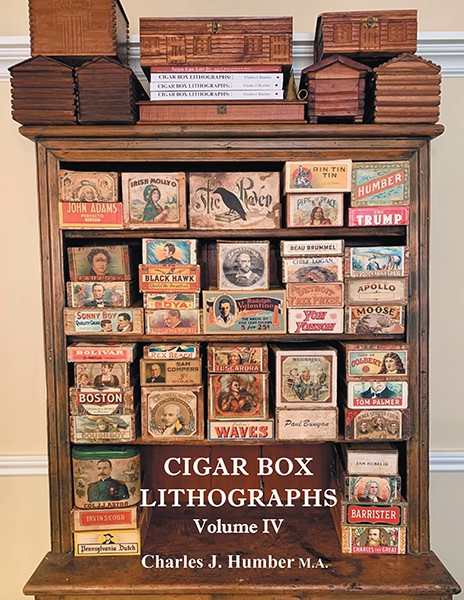Cigar Box Lithographs
Volume IV
Cigar Box Lithographs: Volume IV is a captivating survey of American and Canadian history.
Charles J. Humber’s enthusiastic passion for social history and antiques enriches Cigar Box Lithographs: Volume IV.
Between 1880 and 1920—the halcyon days of cigars, before cigarettes took smoking center stage—a riot of colorful cigar boxes jockeyed for attention on general store and pharmacy counters across North America. New advances in chromolithography and other printing technologies emblazoned eye-catching images on their propped-up lids. These graphics made cigars even more alluring. In this volume, they’re plumbed for lively, nostalgic stories about the Victorian and Edwardian eras.
One hundred twenty cigar box lithographs, including many unique surviving examples, pair with supplementary images from postcards, movie posters, sheet music, and other historical ephemera in this volume. The illustrations are accompanied by folksy, informative descriptions of their subjects, cigar manufacturers, printers, and analyses of their cultural context and rarity.
Many of the featured lithographs feature soldiers, explorers, artists, and political leaders; brief biographies outline the importance and popularity of these figures. Some of the cigar box icons remain well known, including Victor Hugo and Noah Webster, but for the rest, the book’s entertaining introductions are helpful. Populist politician and Declaration of Independence signer Abraham Clark, bestselling novelist Rex Beach, and French Canadian explorer of the Arctic Joseph-Elzéar Bernier are among the most compelling personalities whom the book features.
Other absorbing historical images traipse through the popular culture of the late nineteenth and early twentieth centuries. They lead to intriguing nuggets like how Conestoga wagon drivers’ penchant for chomping cigars lead to the nickname “stogie,” and the tragic story of Swedish balloonist S. A. Andrée, who died while trying to traverse the North Pole. Images and tales of animals, landscapes, early airplanes, and scenes from contemporary plays, songs, and books all add inviting layers of historical interest.
The boxes also depict actions and actors that are unacceptable in contemporary times. The book delves into some cigar box imagery featuring racist and misogynistic stereotypes, with special attention paid to women and Native Americans. Problematic interpretations of how Black Americans are depicted arise, including in the book’s apologetics for the long-running Hambone character in a Tennessee newspaper and in its analysis of an illustration of Uncle Sam surveying Black Americans hoeing a field under the watchful eye of a horseback supervisor. The latter is said to represent “American multiculturalism,” though the visceral reactions it evokes suggest otherwise.
The book’s homespun, flowery prose suits its antiquarian subject matter. Its history tour contains a healthy dose of personal opinions about the past and present; it rails against “political correctness” and laments younger generations’ lack of interest in heroes of yore. These inserts and habitual references to the previous three volumes in the series are discordant filler within an otherwise edifying, entertaining narrative.
Cigar Box Lithographs: Volume IV is an often captivating survey of American and Canadian history, navigated across the lids of breathtaking, old-fashioned cigar boxes.
Reviewed by
Rachel Jagareski
Disclosure: This article is not an endorsement, but a review. The publisher of this book provided free copies of the book and paid a small fee to have their book reviewed by a professional reviewer. Foreword Reviews and Clarion Reviews make no guarantee that the publisher will receive a positive review. Foreword Magazine, Inc. is disclosing this in accordance with the Federal Trade Commission’s 16 CFR, Part 255.

